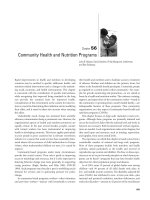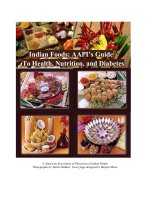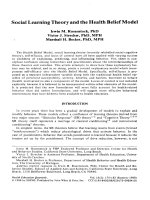Beer Health and Nutrition pptx
Bạn đang xem bản rút gọn của tài liệu. Xem và tải ngay bản đầy đủ của tài liệu tại đây (1.93 MB, 199 trang )
Health and Nutrition
Beer
C. W. Bamforth
Beer
Health and Nutrition
00bpre.indd i 22/03/2004, 16:04:56
From man’s sweat and God’s love, beer came into the world
St Arnoldus
00bpre.indd ii 22/03/2004, 16:04:59
Beer
Health and Nutrition
Charles W. Bamforth
Professor, Department of Food Science and Technology
University of California, Davis
Blackwell
Science
00bpre.indd iii 22/03/2004, 16:05:00
© 2004 Blackwell Science Ltd
a Blackwell Publishing company
Editorial of ces:
Blackwell Science Ltd, 9600 Garsington Road, Oxford OX4 2DQ, UK
Tel: +44 (0)1865 776868
Blackwell Publishing Professional, 2121 State Avenue, Ames, Iowa 50014-8300, USA
Tel: +1 515 292 0140
Blackwell Publishing Asia Pty Ltd, 550 Swanston Street, Carlton, Victoria 3053, Australia
Tel: +61 (0)3 8359 1011
The right of the Author to be identi ed as the Author of this Work has been asserted in accordance with the
Copyright, Designs and Patents Act 1988.
All rights reserved. No part of this publication may be reproduced, stored in a retrieval system, or transmitted,
in any form or by any means, electronic, mechanical, photocopying, recording or otherwise, except as permitted
by the UK Copyright, Designs and Patents Act 1988, without the prior permission of the publisher.
First published 2004
Library of Congress Cataloging-in-Publication Data is available
ISBN 0-632-06446-3
A catalogue record for this title is available from the British Library
Set in 10/14 pt Times New Roman
by Sparks Computer Solutions Ltd, Oxford
Printed and bound in India by
Gopsons Papers Ltd, New Delhi
The publisher’s policy is to use permanent paper from mills that operate a sustainable forestry policy, and
which has been manufactured from pulp processed using acid-free and elementary chlorine-free practices.
Furthermore, the publisher ensures that the text paper and cover board used have met acceptable environmental
accreditation standards.
For further information on Blackwell Publishing, visit our website:
www.blackwellpublishing.com
00bpre.indd iv 22/03/2004, 16:05:00
Dedicated to my forebears
00bpre.indd v 22/03/2004, 16:05:00
00bpre.indd vi 22/03/2004, 16:05:00
Contents
Preface ix
Acknowledgements xiii
1 Beer as Part of the Diet 1
Beer: a vice or a staple part of the diet? 2
Getting beer into perspective 13
What is moderation? 18
But what about addiction? 20
Impacts on behaviour 25
2 Beer Through History 30
Brewing travels west 32
Restraining excess 33
Religious origins 34
Maintaining standards 35
Beer: a nutritious dish for the whole family 37
Temperance pressures 42
Towards prohibition 45
3 The Basics of Malting and Brewing: Product Safety and Wholesomeness 49
Chemical beer? 49
Basic outlines of malting and brewing 63
Styles of beer 69
The chemistry of beer 71
4 The Basics of Human Nutrition 86
Energy 86
Phytonutrients 91
Carbohydrate, fat and protein 91
00bpre.indd vii 22/03/2004, 16:05:00
viii Contents
Vitamins 92
Minerals 93
Fibre 94
Water 95
Balance 95
5 The Composition of Beer in Relation to Nutrition and Health 96
Energy 97
Carbohydrate, fat and protein 105
Water 106
Vitamins 106
Minerals 109
Fibre 112
Comparison of beer with other foodstuffs for nutrient value 112
Potentially deleterious components of beer 116
Beer as a ‘treat’ 117
6 The Impact of Alcohol on Health 120
The metabolism of ethanol 122
Direct and indirect impacts 123
The heart and the circulatory system 124
The liver and the digestive system 135
The reproductive system 139
Brain and cognitive function 142
Kidney and urinary tract 146
Age 147
Cancer 149
Allergy 153
The common cold 154
7 Conclusion 155
References 159
Index 179
00bpre.indd viii 22/03/2004, 16:05:01
Preface
John Hudson peered at me over his half-moons. A rm frown was on his forehead. His
hands were folded rmly on his desk.
‘Say that one more time, lad’, he grunted in his familiar and frequently feared North
Yorkshire accent.
I gulped and let it go one more time.
‘I don’t think the work I am doing here is worthwhile. I mean, I could be research-
ing cancer – something bene cial for mankind. But I’m working on beer – what puts
bubbles on a pint, why lager tastes of sweetcorn, how to choose the best barley. It’s not
exactly crucial, is it?’
I’d been worrying about my raison d’être for some while. Surely my expertise as an
enzymologist could be put to better use?
Hudson, Deputy Director of the Brewing Research Foundation at Nut eld in leafy
Surrey, was unexpectedly calm on that dull winter morning in 1980.
‘Do people drink beer, Charlie?’
‘Well, yes.’
‘Who drinks beer?’
‘Lots of people.’
‘Such as the working class man and woman, for instance?
‘Yeah.’
‘Does it make them happy?’
‘Well, sure, as long as they don’t get drunk, and they can afford it, and nobody suf-
fers as a result of them doing it.’
‘True, but accepting all that, do they like their pint?’
‘Well, yes.’
‘So you don’t think that helping brewers make grand beer, that people will enjoy,
is worthwhile?’
I just looked at him. At that very moment I matured considerably. I realised that my
humble place in society’s tapestry was not insigni cant, that I did have a worthwhile
role to play, and that there was no shame associated with the work that I was doing on
a topic that, admittedly, I found to be fascinating.
00bpre.indd ix 22/03/2004, 16:05:02
x Preface
Dr Hudson wasn’t nished.
‘Don’t forget, lad, that beer has long since been important to the diet of some people.
It gives them energy, vitamins, minerals. It soothes them. Don’t knock it.’
Hudson was a wise man. Irascible for sure, but a man who loved beer in every respect
and would have nobody badmouth it.
I, his young protégé, was certainly receptive to the fact that beer could actually be a
worthy part of the diet. And, for a number of years prior to the conversation in question,
it had formed a prominent part of my social activity, as it did for a great many young
folk in late sixties and early seventies England.
I had my own clear appreciation of the merits and de-merits of alcohol consumption.
As a young biochemistry student at the University of Hull, who worked ludicrously
hard during the week, I looked forward eagerly to the weekend when my buddies and
I would make for old town Hull and its plethora of outstanding pubs.
Sometimes I made a complete fool of myself. My conscience will not allow me to
deny the fact that, from time to time, I imbibed to excess. It didn’t take me long to learn
the lesson, however, that this was disadvantageous, not least from the unpleasantness
of the day after. Before long, though, I had come to understand the pleasure that is to
be had from taking one’s beer steadily and in moderation – a pint or two daily. It tasted
good. It complemented the food I was taking, whether a sandwich, a curry or just a bag
of crisps. It made me mellow and calmed. And, as I usually took the beer in a pub rather
than at home, it was a valuable part of a holistic social experience.
For the majority of my beer-drinking life (33 years of cially – and still counting
loud and strong), I have never contemplated beer in an overtly dietary manner. It has
been taken for pleasure and not as part of a carefully considered diet. Few people would
treat it as a foodstuff per se. And yet, as you will nd from reading this book, beer is
very much a food. It is unreasonable for critics to refer to beer as ‘empty calories’ and,
as we shall see in Chapter 5, it is entirely possible to tally the contribution of calories,
bre, vitamins, minerals, and so on from beer alongside those of the other items on the
dinner table. Proteins and carbohydrates, but (despite the myth) absolutely not fats, are
very much a part of beer as they are of bread, meat, vegetables and cereal. Indeed, what
is beer if it is not lique ed barley with added value?
As consumers become more and more health conscious and aware of the need for
a well-balanced diet, it is not suf cient simply to bracket a product such as beer as
‘something for pleasure’, as if it was just water and contributing no nutritive quotient.
It does kick plenty, in various ways, and people need to be aware of the extent of this
and how it impacts the rest of their intake. It would never be my intention to advocate
beer as an inherent substitute for any other component of the diet. It seems entirely logi-
cal, though, to include beer amongst the diverse other items on the menu in the ready
reckoning exercise and even to fashion a sustaining and, of course, pleasurable meal
00bpre.indd x 22/03/2004, 16:05:02
Preface xi
that incorporates a glass of beer. One less slice of bread perhaps? Skipping the stodgy
or ludicrously sweet dessert?
The supermarket shelves are loaded with diverse choices and all manner of foodstuffs
– forti ed with this or that, low calorie variants, ‘organic’, etc., etc. Beer is no different
– except that there is no overt forti cation going on, rather the inherent components
such as vitamins and minerals that can be in quite useful quantities.
What, I wonder though, would people say if I said that beer might as justi ably be
located in the medicine cupboard as in the larder? The evidence is mounting that mod-
erate consumption of beer (of the order of one to two pints per day) lowers the risk of
mortality and morbidity and has a range of bene cial impacts on the body. When my
wife was in the maternity ward with our rst born, the drinks trolley included stout
alongside the other beverages on offer. It was accepted wisdom that beer is rich in
valuable nutrients, as well as offering a soothing impact after an intense emotional and
physical experience.
It would be stupid to argue against the fact that drinking alcoholic beverages to excess
is dangerous (health-wise and accident-wise) and prone to lead to suffering, both for the
imbiber and for those close to them. It is no surprise whatsoever, therefore, that organi-
sations have sprung up with the aim of attacking the alcoholic beverages industry. It is
equally unsurprising that those within the industry (and, as a professor whose speciali-
sation is beer, I guess this includes me) should seek to counter such sieges. However,
it is important that this is done in a responsible and conscientious manner, and with a
rationality that seems to be too frequently lacking from those who decry alcohol.
The producers of alcoholic beverages must position their products for what they are:
valuable and positive components of the human diet that should be enjoyed responsibly
by adults. They should not be (but, too often, regrettably are) marketed with images of
wild and irrational behaviour. And, when arguments for their positive contribution are
made this should be done in as balanced and critical way as possible.
Would that those who oppose alcoholic beverages take the same approach in con-
sidering all the evidence. Perhaps then more of them might come to accept that, taken
wisely and temperately, beer and other alcoholic beverages are a worthy component
of society. The vast majority of people who take a beer are not drunken drivers, wife
beaters, football hooligans, panhandlers or, above all, alcoholics. And neither will they
go on to become these things. Certainly, excessive alcohol intake can reduce inhibi-
tions that could increase the likelihood that a football yob will wreak havoc. However,
it’s not the alcohol, any more or less than the game of soccer itself, that has made the
thug what he is.
Drinking of alcohol, including as beer, is so often an integral feature of social occa-
sions for adults. As Gus eld (1987) says, a drink is a signal for an important change
of pace or venue.
00bpre.indd xi 22/03/2004, 16:05:03
xii Preface
So, what is someone who has been employed either in the brewing industry or as a
professor teaching its science and technology for a quarter of a century doing writing
this book? Is it, as some will undoubtedly say, an exercise in self serving, an unashamed
piece of biased lobbying to tout one’s favourite beverage? I have very little doubt that
the anti-alcohol lobby will come to that conclusion. With just as much vehemence, I
would refute the inference. I must stress, too, that I have neither been commissioned to
write this book nor am I directly paid by any brewing company. This volume seeks to
discuss beer in a warts-and-all context. I have certainly not fought shy of discussing any
of the adverse impacts that excessive consumption of alcoholic beverages can have.
I was driven to write the book by several forces:
(1) To consider dispassionately the role of beer in the human diet now and through
history, as an exercise in scholarship.
(2) To consider the impact that beer (as part of the spectrum of alcoholic beverages)
has on health, in an era when the average person has probably never been more
conscious of, and concerned about, the state of their well-being.
(3) To redress the balance about the relative worth of beer and wine as bene cial parts
of the diet.
It seems to me that those writing on the topic from within (or closely associated with) the
alcoholic drinks industry tend to cover both the positive and negative aspects of alcohol.
By contrast, those writing from the opposing stance seldom do other than consider the
consumption of alcoholic beverages as entirely negative.
I believe that there is a key need for education, to present facts as we know them
(and as they emerge consequent to state-of-the-art research) and not to shy away from
any facet of the debate. In a class I teach to students of all ages on the Davis campus
of the University of California we endeavour to do just this. I bring in guest speakers
from breweries but also expose the students to medical experts able to articulate the
perils of taking alcohol to excess. Some of the images can be quite gruesome. We want
the students to understand, to nd themselves in this con icting arena.
For after all, is not a maxim from the Temple of Apollo at Delphi (Braun 1996),
‘Know thyself and nothing to excess’?
00bpre.indd xii 22/03/2004, 16:05:03
Acknowledgements
Thanks to Lou Grivetti for hepful discussions. I am grateful to David Long for providing
valuable statistical data and Jaime Jurado for making available analytical data on beers.
As ever, I appreciate my wife Diane for her patience and support.
00bpre.indd xiii 22/03/2004, 16:05:03
00bpre.indd xiv 22/03/2004, 16:05:04
1 Beer as Part of the Diet
Beer has been drunk for more than 6000 years, from the time that it was rst made by
happenstance in the middle age of ancient times (Bamforth 2003). Ever since, it has
become a staple part of the diet in many cultures. Furthermore, it has not only com-
prised a valuable addition to the table, but has served various medicinal roles, including
mouthwash, enema, vaginal douche and applicant to wounds (Darby et al. 1977).
Beer (and other forms of alcohol) differs in its signi cance, acceptability and impor-
tance from culture to culture. At one extreme the prophet Mohammed forbade his fol-
lowers to drink alcohol, thereby establishing a point of difference from Christianity.
The Koran speaks of alcohol as being an ‘abomination and the work of Satan’ (5: 90).
Conversely, the Kofyar of northern Nigeria believe that ‘man’s way to god is with beer
in hand’ (Netting 1964). In the Aztec nation, religious worshippers were obliged to get
drunk for fear of displeasing the gods (Thompson 1940). In India, the various deities
demand different approaches to the use of alcohol. Indeed, in some areas of India, alco-
hol is replaced by infusions of hashish (Carstairs 1957). What better illustration might
one use to stress the need for tolerance of others’ customs and beliefs and of what is
or is not acceptable?
Mandelbaum, in discussing the Tiriki of Kenya, observes:
Beer is a constant medium of social interchange for men; beer drinking is a pre-
occupying activity that few men reject. Drinking beer together induces physical
and social mellowness in men. Very little aggressive behaviour is ever shown as
a result of drinking, and that little is promptly squelched. Pathological addiction
rarely, if ever, occurs.
Mandelbaum (1979)
This thought-provoking view surely reminds us that we should view the consumption
of beer (and other alcoholic beverages) from a holistic standpoint.
The historical importance within society of beer (and other alcoholic beverages,
such as wine in climates where grapes could be grown) is illustrated by the argument
that nomadic tribes gravitated to crop farming and organised communities in order to
ensure a constant supply of beverages (Kendell 1987).
01bch1.indd 1 22/03/2004, 16:05:32
2 Chapter One
In many cultures, especially those of Northern Europe, beer was through generations
the staple drink for the whole family, young and old. At least in part this was on account
of beer being safer to drink than water in days when there were no water puri cation
systems. The ale, after all, had been through a boiling stage, whereas the local supply
of water had not. The ale tasted better too. Cesar de Saussure, a Swiss writing in 1720
(see de Saussure 1902), found in London that:
Though water is to be had in abundance in London, and of fairly good quality,
absolutely none is drunk. In this country beer is what everybody drinks when
thirsty.
The early settlers in Virginia fell sick for want of ale, on account of the local infected
water that they were obliged to drink. One of the rst settlers, Richard Ffrethorne,
bemoaned the lack of any creature comforts, bitter that back in England folk were
healthy on their strong ale whereas here there was only water to drink (Kingsbury
1906–1935).
It was only with the development of cleaner water and the advent of tea and coffee
drinking in the seventeenth century that beer in countries such as Great Britain progres-
sively shifted away from being the staple beverage at mealtimes for all members of the
family unit, and became more of a luxury item.
Yet there remain cultures, notably the Czech Republic and Germany, where the
consumption of beer to accompany a meal remains a key feature of the diet, which is
re ected in the per capita consumption gures (Table 1.1).
Beer: a vice or a staple part of the diet?
Were we able to transport ourselves back to the Middle Ages and enquire in England,
Flanders, Bavaria or Bohemia about the key features of the popular diet, ale or beer
would unquestioningly and unhesitatingly be listed alongside meat, bread, milk and
vegetables. The questioner would be regarded as being mightily peculiar if he or she
were to question ale’s legitimate place on the table. It was neither a comfort food nor
an extravagance. It was an integral part of the food intake in all walks of society. In
eighth-century England a monk might consume eight pints of ale a day.
Beer in Britain has long been considered to be a key part of the diet, as much so as
wine in France. Henry Brougham MP (Brougham 1830) said that ‘To the poor the beer
is next to a necessity of life.’
Over 50 years ago the nutritive value of beer was emphasised. An admittedly weakish
beer [3% alcohol by volume (ABV) in the austere early post-war years] was claimed to
provide 200 calories and a fth of a working man’s requirement for calcium, phosphorus,
01bch1.indd 2 22/03/2004, 16:05:33
Beer as Part of the Diet 3
Table 1.1 Worldwide consumption of beer, 2000.
Country Consumption (litres per head)
Argentina 32.7
Australia 90.0
Austria 107.0
Belgium* 98.3
Brazil 48.2
Bulgaria 51.0
Canada 67.4
Chile 27.5
China 17.3
Colombia 32.7
Croatia 86.2
Cuba 20.3
Czech Republic 158.9
Denmark 98.6
Finland 80.2
France 35.9
Germany 123.1
Greece 39.0
Hungary 73.0
Ireland 125.0
Italy 28.9
Japan 55.9
Korea (Republic of) 35.5
Mexico 48.3
New Zealand 79.5
Netherlands 80.5
Nigeria 5.6
Norway 52.0
Peru 22.8
Philippines 15.9
Poland 62.8
Portugal 61.3
Romania 55.4
Russia 37.9
Slovak Republic 87.1
Slovenia 92.0
South Africa 53.8
Spain 72.0
Sweden 56.4
Switzerland 58.3
Ukraine 21.1
UK 95.4
USA 82.4
Venezuela 76.0
*Includes Luxembourg, because of inaccuracies introduced
by cross-border trading.
Source: Tighe (2002).
01bch1.indd 3 22/03/2004, 16:05:34
4 Chapter One
nicotinic acid and ribo avin (Bunker 1947). The satisfaction of having at least part of
one’s dietary intake in a pleasurable form was not sneered at then.
Perhaps the rst person to conduct a serious study of the impact of abstinence, mod-
eration and excessive drinking on health was statistician Raymond Pearl. On the basis
of interviews with over 2000 workers in Baltimore, he concluded almost 80 years ago
that on average moderate drinkers lived longer than abstainers and much longer than
those who were heavy drinkers (Pearl 1926).
Yet now, at the dawn of the twenty- rst century, beer-drinking is regarded in many
societies as a vice. It is surely astonishing that in the United States it is possible to buy
cigarettes at the age of 18, but it is not legal to purchase alcohol until the age of 21. It
would be a struggle to identify any merit associated with smoking, with the possible
exception of its role as an anxiety relaxant. By contrast there is accumulating evidence
that alcohol, including beer, in moderation can have a bene cial impact on health and
wellbeing.
In passing, let us consider the legal age at which, in the US, it is possible to partake
of other activities that surely might be considered a genuine risk to health and wellbe-
ing, not only for the partaker but also for those around them. A child may legally drive
a car, with relatively few restrictions, at the age of 16. More alarmingly, 35 states in
the US have no licensing or registration requirements for guns (www.soros.org/crime/
higlights.htm). Seven states lack a legal minimum age for buying a ri e or shotgun
from an unlicensed dealer, while six states have no legal minimum age for a child to
possess a handgun. In ve states there is a minimum age – 16 in New York, Georgia,
Vermont and Alaska, and just 14 in Montana. But the minimum legal age for drinking
alcohol in all 50 states is 21!
Opinions about the relative merits and de-merits of smoking, driving, guns and alcohol
will of course differ between individuals. Certainly if we consider the respective virtues
of smoking, weapon use and alcohol (in restraint), then it seems to this author that there
may be a warped set of priorities in one country at least. Nonetheless beer is the second
most popular drink in the United States, with annual average per capita consumption at
357 8-ounce servings, after sodas and other soft drinks (861) (Beverage Digest 1998).
Worldwide production of beer in 1999 ran at 0.13 billion litres.
It seems that we have lost sight of the real bene ts of a foodstuff such as beer (and
it is a foodstuff, as we will explore in Chapter 5) for the body and for overall wellbe-
ing. P.G. Wodehouse, in The Inimitable Jeeves, wrote: ‘It was my Uncle George who
discovered that alcohol was a food well in advance of modern medical thought.’
In Pearson’s Weekly (a rival to Tit-Bits and founded in 1890 by Sir Arthur Pearson, who
went on to create the Daily Express), Bass Ale received the following testimonial:
An old friend of mine, Colonel Worsley CB, when in India, had a very dangerous
attack of dysentery and was given up by the doctors. When dying as it was thought,
01bch1.indd 4 22/03/2004, 16:05:34
Beer as Part of the Diet 5
he begged the man in a faint whisper to give him some Bass and as it was thought
his case was hopeless he was humoured. He then drank pint after pint and began
to get better as soon as his yearning was satis ed much to the astonishment of the
doctors and brother of cers.
Despite the fact that once upon a time I was research manager with Bass, I can’t believe
that there was anything magical about Bass Ale to make it superior in the context
quoted as compared to any other beer. I remain open-minded about the veracity of the
report, and about the likelihood of a causal link between Worsley’s wellbeing and the
consumption of beer.
The claims for Bass have been various. Doctors in its town of origin, Burton-on-
Trent, are said to have recommended it as a laxative. Writing in The Times, Dr Mapother
recommended Bass as a cure for gout. It is claimed that Bass cured Edward VII, when
Prince of Wales, of typhoid. Perhaps this stimulated the music-hall song that ran
I’ve tasted hock and claret too, Madeira and Moselle
But not one of those boshy wines revives this languid swell
Of all complaints from A to Z the fact is very clear
There’s no disease but what’s been cured by Bass’s Bitter Beer.
Remarkable testimony! But Bass isn’t the only brand to have been championed in this
way. 1928 saw Guinness launch the slogan Guinness is Good for You, and followed it
with such as My Goodness, My Guinness and Guinness for Strength (Fig. 1.1).
The sweet stout, Mackeson, was marketed in the 1950s on a slogan of:
It looks good, it tastes good,
And, by golly, it does you good.
Nursing mothers were expected to enjoy a daily bottle of stout.
Those were the days when some governments were not hesitant to see the virtues
that beer had as a social cement and catalyst of contentment. As Queen Victoria had
said rather earlier: ‘Give my people plenty of beer, good beer and cheap beer, and you
will have no revolution among them.’
The British government in the middle of the last century was totally happy to see the
trade association The Brewers Society champion their members’ products with generic
messages including For Bodily Health – Beer is Best and To Set A Man up for Winter
– Beer is Best and For an A1 People – Beer is Best (Fig. 1.2).
Predictably, the temperance lobby countered with Beer is Best Left Alone.
01bch1.indd 5 22/03/2004, 16:05:35
Fig. 1.1 Marketing slogans from Guinness. (a) Poster from 1932. The seven pints represented both the days
of the week and the seven beneficial reasons for drinking Guinness: ‘strength, nerves, digestion, exhaustion,
sleeplessness, its tonic effects and for the blood’. (b) Poster from 1945. The Ministry of Information’s ‘Dig
for Victory’ slogan was adapted and integrated into the ‘Guinness for Strength’ campaign. The GUINNESS
(a)
01bch1.indd 6 22/03/2004, 16:05:35
word, HARP device and ARTHUR GUINNESS signature are trade marks and are reproduced together with
the ‘Poster from 1932’ and ‘Poster from 1945’ advertisements with the kind permission of Guinness & Co.
Guinness & Co. All Rights Reserved. The ‘GUINNESS IS GOOD FOR YOU’ advertising campaign dates from
the 1930s to 1960s and has not featured in subsequent campaigns to advertise GUINNESS beer.
(b)
01bch1.indd 7 22/03/2004, 16:05:38
8 Chapter One
Fig. 1.2 (a)–(e) Marketing slogans from the Brewers Society. Reproduced courtesy of the British Beer &
Pub Association (formerly The Brewers Society).
(a)
01bch1.indd 8 22/03/2004, 16:05:41
Beer as Part of the Diet 9
(b)
Fig. 1.2 (Continued.)
01bch1.indd 9 22/03/2004, 16:05:44
10 Chapter One
(c)
Fig. 1.2 (Continued.)
01bch1.indd 10 22/03/2004, 16:05:47









